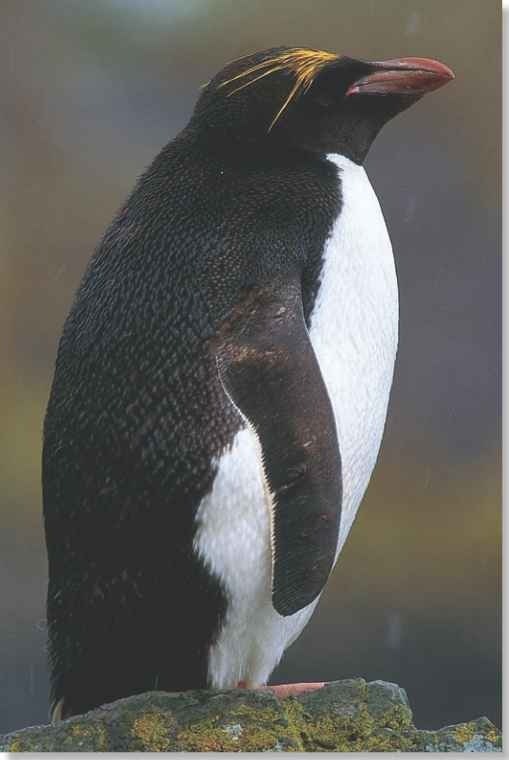ORDER
Sphenisciform.es
FAMILY
Spheniscidae
GENUS & SPECIES
KEY FEATURES
• Named for its long golden crests, which resemble the flashy feathers worn by 18th-century Englishmen
• Breeds in extremely dense colonies and interacts socially within them
• Monogomous and devoted parents, macaroni penguins will spend up to 45 days fasting when caring for chicks
WHERE IN THE WORLD?
Found on sub-Antarctic I islands in the South F Atlantic and Indian Oceans and the Falkland Islands off of Argentina; also in the t waters south of South America and Africa
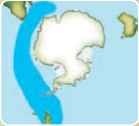
Lifecycle
Macaroni penguins spend two years with their chick. While one parent ventures out, sometimes for several days, the other parent cares for the young and fasts.
Habitat
The macaroni penguin has two separate habitats. Outside the breeding season, the bird is believed to be completely pelagic, living in the open waters of the Antarctic and sub-Antarctic; it cannot be found at nesting colonies or other land areas. Breeding colonies are established on steep rocky slopes, headlands and on level ground areas of the islands falling within its general habitat range. Although
the macaroni prefers areas devoid of vegetation, some have been known to nest on patches of tussock grass on the edges of large breeding colonies.
► Plenty of penguins Macaroni penguin breeding colonies can consist of up to 100,000 breeding pairs.
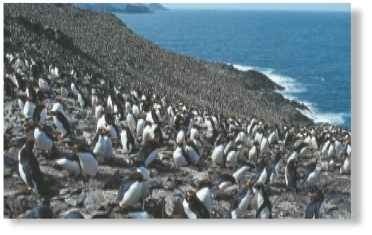
Conservation
With over 1 1,000,000 breeding pairs, macaroni penguin populations are stable with no major threats, although some species of gull will feed on abandoned eggs, and leopard and Atlantic fur seals will occasionally feed on adults at sea.
Behavior
With such a crowded, complex and social living structure, it is not surprising that macaroni penguins exhibit a wide variety of gestures and vocalizations. Calls seem to be associated with location of a mate, fighting and sexual activity, and tend to vary in length, pitch and associated gestures. Macaronies are extremely vocal during territory establishment and pair formation, with much chattering and trumpeting. However, despite their often massive size, breeding colonies tend to be rather quiet during incubation, with occasional spurts of activity occurring whenever one parent returns from a foraging trip and during the “changing-of-the-guard” at the nest. Parents recognize each other as well as their chicks by voice; they use loud trumpeting from a distance and a quivering, chattering call when close up. Quite social with each other, some colonies will also nest in harmony with different species of albatross living just outside their colony.
A Taking the plunge A penguin prepares to dive in for a hunt.
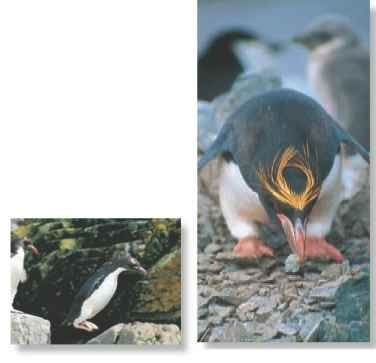
A Rocky home
Macaroni penguins prefer steep, rocky slopes.
lightning strike

Do not disturb
Macaroni penguins attempt to make their way through the crowded nesting site without disturbing other birds by following access routes.
Take that!
Sometimes the aggression may lead to bill jousting, where both parties will lock bills and attempt to force each other to the ground.
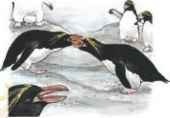
breeding

No trespassing…
Although usually peaceful, other birds, when disturbed, may exhibit aggressive behavior with loud calls and even flipper smacks.
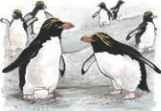
Home sweet home
When the penguin reaches home, the pair greet each other with vocalizations and bowing as they prepare for nest relief.
Some males have been known to make foraging trips of up to 270 hours.
The macaroni penguins were named after a group of Englishmen who wore fancy feathers in their hats and introduced Italian macaroni to England.
Changing shifts Both parents take turns protecting the vulnerable nest and greet each other vocally whenever one returns after searching for food for the chick.
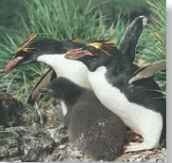
Food & hunting
During the nonbreeding season, the macaroni penguin feeds primarily on crustaceans, cephalopods and small fish. When the chicks are young, they are fed crustaceans, with cephalopods and small fish being added to the diet as the chicks grow larger. The tongue and palate are equipped with spines in order to better grip fish, squid, krill and other slippery prey. The macaroni usually forages during the day, with trips averaging 12 hours, but during chick-rearing, trips last 25-50 hours. Macaroni penguins are superb divers; during a long foraging trip, they spend about 10% of their hunting time diving underwater in search of prey. When diving, they can reach depths of almost 400′, although they average about I 30′ during the day and 10′ at night. Though they can be underwater for several minutes, the average length of a dive is 1.5 minutes.
Macaroni menu Macaroni penguins take to the water to hunt
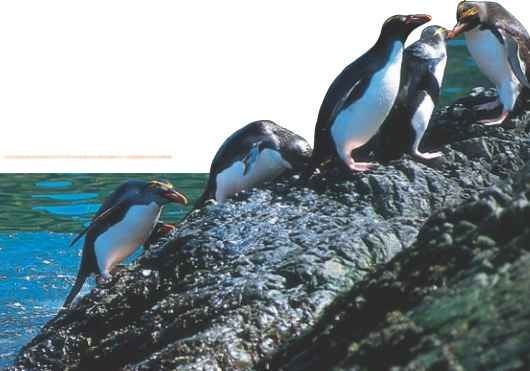
Macaroni penguins tend to be at sea from April through October and arrive at colonies between October and November. Once they find their mate within the colony, they greet each other with much trumpeting, head shaking and bowing. The pair, which mates for life, will then construct a nest consisting of a shallow scrape in the mud or gravel lined with a few small stones. In late November to December, a clutch of two eggs is laid, the first being about 60% smaller then the second. Incubation takes about 33-37 days; both parents incubate the eggs for the first 8-12 days, the female incubates them for the following 12-14 days, and the male incubates them for the last 9-11 days. Hatching of the young takes 24-48 hours from pipping (first breaking through the shell) to emergence from the egg, but usually just the larger second chick survives. The father guards the nest for another 25 days while the female forages for food. After 25 days several chicks will convene together to form nurseries. The father then returns to sea to forage. For about 10-20 days the chicks will be fed by both parents at increments of about every 1-2 days, and the fledging period lasts about two months.
PROFILE
Macaroni Penguin
With its three layers of feathers and stores of fat, the macaroni penguin is superbly equipped for living in the chilly waters of the Antarctic.
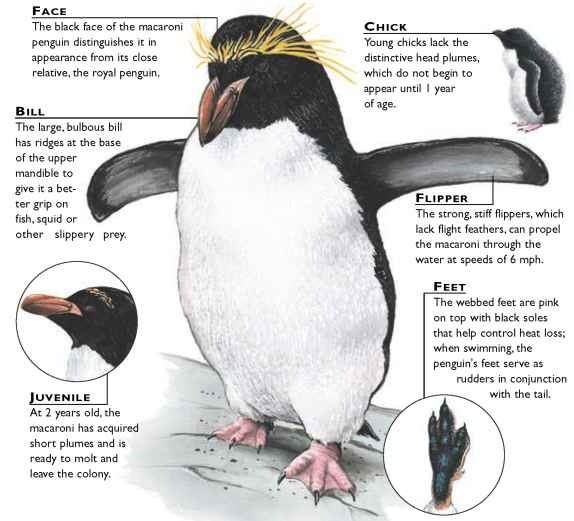
Creature comparisons
The royal penguin (Eudyptes schlegeli) is nearly identical to the
macaroni penguin; the main difference is the white face of the
royal relative.The royal penguin is slightly larger than the
macaroni penguin, but these two species are so similar that
many scientists regard the royal penguin as a subspecies of,
or merely a color variation of, the macaroni penguin. Some
macaroni penguins have appeared with coloring similar to the
royal penguin’s, but it is unknown whether these are mutations or
hybrids.The royal penguin consists of about 85,000 breeding pairs in
about 57 colonies all located on Macquarie Island off of southern Australia.
Royal penguin

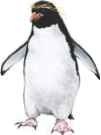
Macaroni penguin
| VITAL STATISTICS | |
| Weight | 11-13 lbs. |
| Height | 28″ |
| Sexual Maturity | Female 5 years; male 6 years |
| Breeding , Season | October-December … |
| Number of Eggs | 2, with only 1 surviving |
| Incubation Period | 60-70 days |
| Fledging Period | 2 years |
| Typical Diet | Fish, squid, crustaceans, and krill |
| Lifespan | Unknown |
RELATED SPECIES
• The Spheniscidae family consists of 6 genera and 17 species of penguins, all of which are flightless birds living I in or around Antarctica. The genus Eudyptes is the largest of the genera and is made up of 6 species of crested penguins. All penguins stand upright and walk with a shuffling gait. They range in size from the little blue penguin, E. minor, to the emperor penguin, Aptenodytes forsteri.
